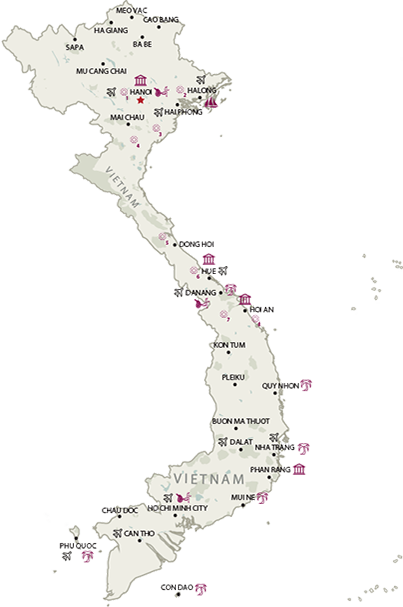Bac Ninh Overview
Bac Ninh is a province of Vietnam, located in the Red River Delta of the northern part of the country. It is situated to the east of the Vietnamese capital, Hanoi, and borders Bac Giang province, Hung Yen province, Hai Duong province, Vinh Phuc province, and Hanoi. The province is rich in culture and is known nationally for Quan ho folk music.
Topography
Bac Ninh has a rather even and flat terrain, mainly sloping from north to south and west to east, causing currents to flow down into Duong River and Thai Binh River. The terrain odd is not much; field areas are 3-7m high and hill and mountain areas are 300-400m high above sea level. Its hills and mountains only make up 0, 53% of its natural area mainly in 2 districts of Que Vo and Tien Du. Besides, there are shallow depressions along dykes under districts of Gia Binh, Luong Tai, Que Vo, and Yen Phong.
Climate
Thanks to the geographical location, Bac Ninh’s climate condition is featured by the influence of tropical monsoon and is clearly divided into four main seasons: Spring, Summer, Autumn and Winter. The annual average temperature is approximately 24ºC. There are two main seasons in one year: rainy season lasts from May to October and dry season lasts from December to April next year.
Tourism
In the past, Bac Ninh used to be an ancient trade center of Vietnam from the 2nd to 10th century. The province is the home of Buddhism, which penetrates into this land so early, and bloomed in the Ly Dynasty. Hence, when traveling to Bac Ninh, visitors will be impressed by a system of old pagodas and temples which reflect its cultural characters and architecture style of Buddhism. Some well-known pagoda to be named in Bac Ninh include Keo Pagoda, Dau Pagoda, But Thap Pagoda, Phat Tich Pagoda, Do Temple, etc. Such pagodas are part of the precious tangible cultural value of the province which has been preserved through generations. Besides the tangible cultural values, Bac Ninh also possesses intangible values which are featured by the traditional festivals. Most festivals of the temples and pagodas in the province take place in spring. Therefore, after the Lunar New Year, Bac Ninh is a favorable destination for visitors from all over the country. Especially, for foreign tourists, Bac Ninh is famous for being the cradle of Vietnam’s traditional folk song –"Quan Ho". “Quan Ho” was recognised as the Intangible Cultural Heritage by the UNESCO in 2009. This kind of art is annually performed at Lim Festival which is often celebrated on 13th of the first lunar month. For foreign tourists, the experience of joining this festival, listening to “Quan Ho” songs will be an unforgettable experience. Bac Ninh is also well known for its traditional handicraft villages such as Dong Ky Wood, Dong Ho Paint, Dai Bai Bronze, and Phu Lang Pottery. Visitors can drop by and join in the daily life of the villagers. Especially, you can try making some products on your own and take them home as small gifts for your beloved ones.
Transportation
Bac Ninh is 30km from Hanoi, 110km from Haiphong, 20km from Bac Giang, 45km from Noi Bai International Airport. It is on the National Highway No.1A, 18, 38.








.png)
